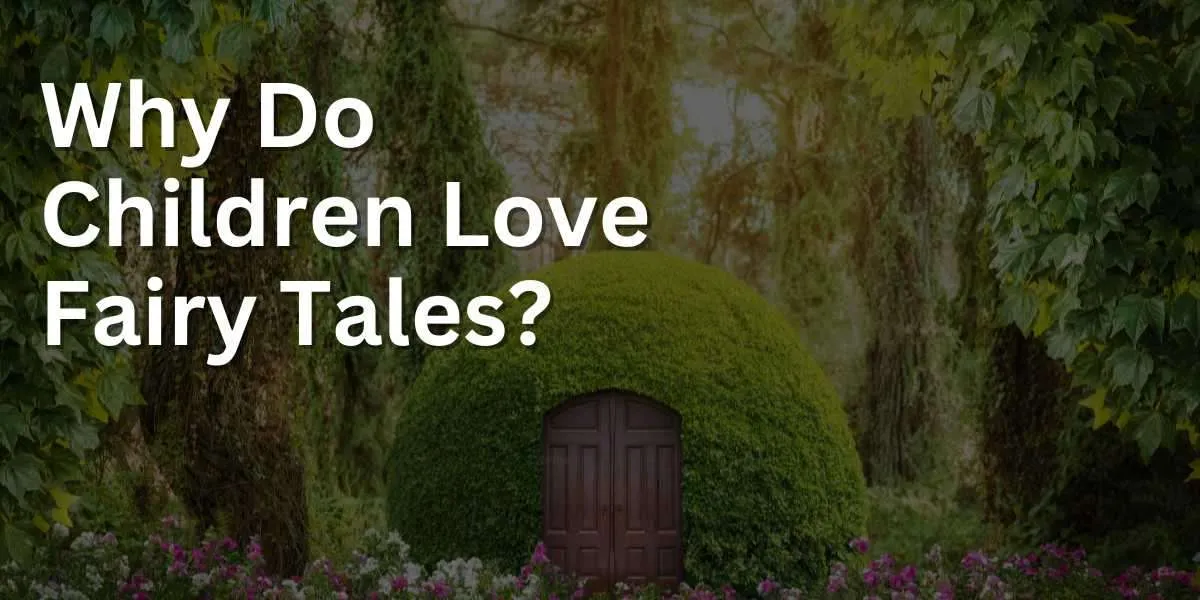From time immemorial, fairy tales have captivated the hearts and minds of children and adults alike. These enchanting stories have not only entertained us but have also served as powerful tools for nurturing our imagination, teaching valuable life lessons, and fostering emotional connections.
In a world that is increasingly driven by technology and instant gratification, fairy tales remind us of the timeless charm of storytelling.
In this post, let us explore the magic of these enchanting tales and understand “why do children love fairy tales” so much.
Key Takeaways
Fairy tales foster imagination, curiosity and adventure in children.
They provide life lessons about courage, love and hope to help them better understand their own feelings.
Reading fairy tales together encourages empathy & compassion while strengthening the bond between parents & children.
The Magic of Imagination

Fairy tales kindle the spark of imagination in children with their magical elements, talking animals, and thrilling adventures.
As famously suggested by Albert Einstein, these tales effectively nurture a child’s intelligence. Regular reading sessions can significantly aid their development and promote cognitive skills.
The frequent reading of fairy tales goes beyond entertainment, providing numerous benefits for the mental development of children. Such reading experiences stimulate creativity and play a significant role in fostering intellectual growth.
The Power of Talking Animals
Unique to fairy tales, talking animals mirror human attributes by speaking, thinking, and behaving like us. They often assist the protagonist, adding a touch of wonder to the narrative.
When choosing fairy tales for children, talking animals captivate their interest because they are often depicted as wise and supportive characters. They also bring a fresh viewpoint to the narrative, as they can provide advice and direction to the protagonist.
Talking animals in fairy tales inspire children to learn about the natural world by offering them a fascinating view of the environment, which can be applied to their everyday life.
This unique perspective helps children to appreciate the beauty and complexity of the world around them, fostering a sense of wonder and curiosity.
Dragons and Adventures
Dragons and other mythical entities in fairy tales, often endowed with magical powers and imparting moral lessons, are fascinating additions to traditional tales and legends.
Children find creatures like dragons so exciting because they represent a world of exciting adventure and captivating mystery, making them wonder if dragons exist in real life. They are often larger than life and can do things that are seemingly impossible in the real world.
These creatures offer children the opportunity to explore a world of fantasy and imagination when they read fairy tales.
They can embark on daring quests, triumph over evil forces, and even become a hero. This sense of adventure and wonder is what makes fairy tales such a powerful and timeless form of storytelling.
Emotional Connections and Life Lessons

Fairy tales nurture emotional bonds, enhancing children’s connectivity and understanding of others. They trigger a spectrum of emotions, from joy to enthusiasm, and even fear, thereby allowing children to safely navigate and process their feelings.
Fairy tales also teach emotional resilience and the ability to adapt in the face of challenging situations. Furthermore, fairy tales offer us many valuable lessons about:
life
friendship
being a human being
love
Through relatable characters and situations, children learn about the importance of courage, perseverance, and the beautiful power of love. Love is a powerful force that can transform any story. It always works its magic in the most unexpected ways.
As children navigate the emotional landscape of fairy tales, they are better equipped to handle their own emotions and empathize with others in real life.
Happily Ever After
Fairy tales that conclude on a happy note inspire joy and provide valuable lessons about overcoming adversity. They instill comfort and optimism, reinforcing the belief that any challenging situation can be triumphed over, much like in a fairy tale.
People who love fairy tales often find solace in these stories, as they serve as a reminder that good can prevail. Tales teach valuable life lessons, and for those seeking more fairy tales, this love for the genre only grows stronger.
Fairy tales with happy endings can encourage children to believe that they can overcome any challenge with courage, determination, and perseverance. These happy endings not only provide comfort and hope but also serve as a reminder that goodness and love, like a love fairy, always prevail in the end, even in the same fairy tale.
By reading stories with positive outcomes, children are reassured that even in the darkest of times, there is always a light at the end of the tunnel.
Facing Fears and Consequences
Facing fears and consequences in fairy tales can foster:
Resilience
Emotional intelligence
Problem-solving skills
Moral understanding
A feeling of empowerment
Fairy tales, such as Little Red Riding Hood, can positively contribute to children developing resilience by providing them with an opportunity to confront their fears and gain insight into the consequences of their actions.
Fairy tales can positively influence children’s emotional intelligence by guiding them to recognize and appreciate their own emotions and the emotions of others. They can empower children to think critically and creatively to find solutions to difficult situations, thereby helping them to develop problem-solving skills.
Through these engaging narratives, children can learn to face their fears and understand the consequences of their actions, ultimately becoming more emotionally intelligent and resilient individuals. These stories help children in their personal growth journey.
Cultural Diversity and Universal Themes

Fairy tales offer children an exciting opportunity to gain a better understanding of the world around them by exposing them to different cultures. They provide a chance to explore different cultures and customs, which can help them to become more tolerant and accepting of others.
Inspiring themes found in fairy tales include:
Good triumphing over evil
Courage
Perseverance
The beautiful power of love
These timeless themes resonate across cultures, fostering understanding and acceptance among children.
Snow White and Cinderella Around the World
Snow White and Cinderella are two of the most beloved fairy tales in the world. They tell the inspiring story of two young women who courageously triumph over adversity to find joy. These tales are significant in fairy tales as they demonstrate:
The power of good over evil
Teach children valuable lessons about conquering difficulties to find joy
Symbolize gender role stereotypes and the value of beauty
Different cultures portray Snow White and Cinderella in various ways, reflecting their unique values and beliefs. For example, in some cultures, Snow White is seen as a strong and independent woman, while in others she is seen as a more traditional and submissive woman.
Similarly, Cinderella is seen as a symbol of hope and perseverance in some cultures, while in others she is seen as a symbol of ambition and resourcefulness.
Through these diverse portrayals, children are exposed to the rich tapestry of human experience, fostering their appreciation for cultural diversity.
The Common Language of Fairy Tales

The common language of fairy tales provides us with a shared cultural language that helps us to easily connect with each other. They enrich every culture and language, offering a delightful shared experience of storytelling. Fairy tales inspire children to learn about:
values
customs
beliefs
traditions
Fairy tales empower children to:
Face real-life fears and adversity
Pass down generations of wisdom
Enrich cultural literacy
Explore and appreciate the diverse cultural landscape of our world
Foster understanding and empathy across different cultures and generations.
Critical Thinking and Reading Comprehension

Fairy tales are important tools for promoting critical thinking skills and reading comprehension in children. By analyzing, evaluating, and reasoning through story elements, characters, and plot, children develop their creativity, imagination, and problem-solving skills.
They also gain insight into the underlying messages, themes, and morals of the tales, which can be applied to real-life situations. By exposing children to fables and parables, we can positively influence their perspective, making them realize that issues aren’t as daunting as they seem in their minds.
Choosing the Right Tale
Choosing fairy tales suitable for children between the ages of 3 and 10 is fundamental in nurturing their comprehension of intricate narratives and fueling a love for reading. Parents could consider engaging stories from diverse cultures with relatable characters as well as provding a wide range of fairy toys.
By choosing the right tale, parents can ensure that their children are exposed to inspiring examples of complex themes, characters, and cultural diversity.
Moreover, parents can foster critical thinking and reading comprehension in their children by engaging them in reading fractured fairy tales and discussing the differences between the original and the new version.
These alternative takes on traditional stories encourage children to think creatively and explore new perspectives, further enriching their literary experience.
Fractured Fairy Tales
Fractured fairy tales are stories that:
Take traditional fairy tales and twist them in an exciting and innovative way
Often change the characters, plot, or setting
Provide a unique and captivating perspective on traditional stories
Allow for boundless creativity and imagination
Blend familiarity with something new
Engage and thrill both children and adults
By reading fractured fairy tales, children are inspired to think creatively about traditional stories and discover alternative perspectives. This exploration of new viewpoints expands their understanding of the world and the stories that shape it, making them more open-minded and critical thinkers.
The Bonding Experience of Reading Fairy Tales

Shared reading of fairy tales presents a fantastic opportunity to:
Strengthen familial bonds
Create cherished memories
Facilitate understanding and empathy among family members
Provide parents with a unique chance to impart their values and beliefs
Through this shared activity, families can strengthen their connections and foster a love for reading and storytelling that lasts a lifetime.
Bedtime Stories and Family Traditions
Bedtime stories and family traditions are pivotal in forging enduring memories and relationships. They imbue children with a sense of comfort and security, fostering a shared experience that deepens the bond between parents and children.
Reading fairy tales together as a family tradition not only instills a love for literature but also helps to foster meaningful communication and greater understanding between family members.
By establishing these traditions, families create a nurturing environment where children can develop their imagination, critical thinking, and empathy. This shared experience enriches the lives of both parents and children, leaving a lasting impact that transcends generations.
Encouraging Empathy and Compassion
Empathy and compassion are invaluable qualities that can be nurtured through the reading of fairy tales. These stories allow children to relate to the characters and their situations, fostering empathy and compassion for others.
By understanding the feelings and experiences of others, children can expand their emotional intelligence and become more empathetic individuals.
Fairy tales also provide children with the opportunity to reflect on their own emotions and learn how to manage challenging situations.
By exploring the emotional landscape of these stories, children develop a deeper understanding of themselves and others, ultimately becoming more compassionate and empathetic individuals.
Frequently Asked Questions
Why are we fascinated by fairy tales?
We are so deeply fascinated by fairy tales because they represent our collective understanding of human experience, allowing us to relate our deepest emotions and aspirations to characters, themes, and stories that we all know.
What psychological impact do fairy tales have on children?
Fairy tales can be a positive influence on children, providing an imaginative space for them to learn real-life lessons and develop their emotional intelligence.
How do fairy tales make children intelligent?
Fairy tales provide children with invaluable opportunities to develop problem-solving and emotional intelligence skills, encouraging them to explore their imagination and be creative thinkers.
Why are fairy tales important for children?
Fairy tales are important for children as they stimulate their imagination, teach valuable life lessons, foster emotional connections and expose them to diverse cultures and universal themes, helping shape and enrich their development.
How do talking animals in fairy tales engage children’s curiosity?
Talking animals in fairy tales engage children’s curiosity by providing wise and supportive characters, which offer a unique perspective on the story.




